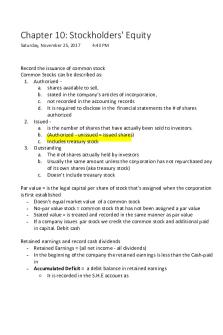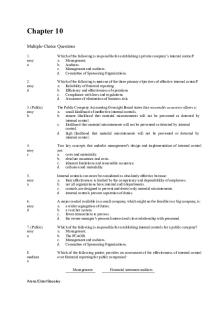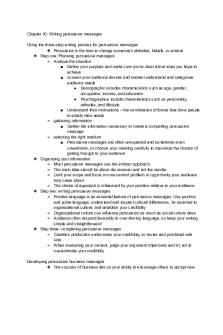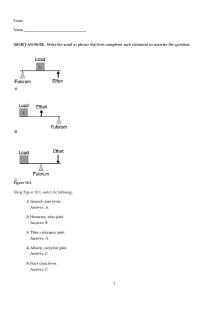Chapter 10 Stockholders\' Equity PDF

| Title | Chapter 10 Stockholders\' Equity |
|---|---|
| Author | Samantha Filetto |
| Course | Principles Of Accounting |
| Institution | Baruch College CUNY |
| Pages | 8 |
| File Size | 109.7 KB |
| File Type | |
| Total Downloads | 70 |
| Total Views | 139 |
Summary
instructor Ming Deng, Notes from Textbook...
Description
Chapter 10: Stockholders' Equity Saturday, November 25, 2017
4:43 PM
Record the issuance of common stock Common Stocks can be described as: 1. Authorized a. shares available to sell, b. stated in the company's articles of incorporation, c. not recorded in the accounting records d. It is required to disclose in the financial statements the # of shares authorized 2. Issued a. is the number of shares that have actually been sold to investors. b. (Authorized - unissued = issued shares) c. Includes treasury stock 3. Outstanding a. The # of shares actually held by investors b. Usually the same amount unless the corporation has not repurchased any of its own shares (aka treasury stock) c. Doesn’t include treasury stock Par value = is the legal capital per share of stock that's assigned when the corporation is first established - Doesn’t equal market value of a common stock - No-par value stock = common stock that has not been assigned a par value - Stated value = is treated and recorded in the same manner as par value - If a company issues par stock we credit the common stock and additional paid in capital. Debit cash Retained earnings and record cash dividends - Retained Earnings = (all net income - all dividends) - In the beginning of the company the retained earnings is less than the Cash-paid in - Accumulated Deficit = a debit balance in retained earnings ○ It is recorded in the S.H.E account as
-
§ Total paid-in capital § Less: accumulated deficit § Equals SHE Dividends ○ Provides useful information about its future prospects § An increased dividend is often perceived as good news § Companies tend to increase when the company is doing well ○ Declaration date § When the board of directors declares the cash dividend to be paid § On this date we increase the dividends account and increase the dividends payable account ○ Record date § When the company will determine the registered owners of stock and, therefore, who will receive that dividend ○ Payment date § The date of the actual distribution of dividends ○ Property dividend = the distribution of a noncash asset to stockholders
Effect of stock dividend and stock splits - Stock dividends/splits = when the company distributes additional shares of the company rather than cash - Stock dividends that are 25% or higher are considered to be larges stock dividend - Your stock value is the same but your stock number is increased so that your stocks are worth less. (recorded at par value) - The accounting equation doesn’t change - Don’t have to record, - 2-for-1 means - Small stock is less than 25% , (recorded at market value) Statement of stockholders equity - Period of time - Return on equity: ○ Measures the ability of company management to generate earnings from the resources that owners provide ○ (ROE = net income/average stockholders equity) ○ Higher is better - Dividend yield:
-
-
○ How much a company pays out in dividend relative to its share price ○ ( = dividends per share/stock price) ○ Higher means more dividends have been doled out to investors Earnings per share: ○ Measures the net incomes earned per share of common stock ○ [(net income - dividends on preferred stock) / average shares of common stock outstanding ] ○ Useful to compare earning performance for the same company over time § **not useful for comparing earning between 2 companies Price - earnings ratio: ○ Indicates how the stock is trading in relation to its currents earnings ○ ( = stock price / earnings per share)
Corporation: an entity that is legally separate from its owners and even pays its own income tax Articles of incorporation= describes the nature of the firm's business activities, the shares to be issued, and the composition of the initial board of directors. Advantages of corporate ownership
Disadvantages of corporate ow
1. Limited liability 1. Additional taxes - Guarantees that stockholders in a corporation can - Double taxation: they lose no more than the amount they invested in the pay tax on when they 2. More paper work company, even in the event of bankruptcy 2. Ability to raise capital and transfer ownership - additional paperwork adequate disclosure o - An investor can sell their share in stock at any time and creditors need. Paid-in capital = the amount stockholders have invested in the company Retained earnings = is the amount of earnings the corporation has kept or retained in the business Treasury Stock = is the corporation’s own stock that it has reacquired. Publicly held corporation - Trades on the NYSE or NASDAQ or over the counter trading - Regulated by the SEC ○ A lot of additional reporting and filing requirements Pi h ld ti
ership pay income taxes and they istributed dividends intended to ensure the information investors
Private held corporation - Doesn’t allow investment by the general public - Normally has fewer stockholders than a public corporation - Don’t need to file with the SEC Stockholders - Owners of the company - The right to vote - The right to receive dividends - The right to share in the distribution of assets ( if a company s dissolved) Preferred Stock - Flexibility - Convertible - Redeemable - Cumulative ○ Unpaid dividends = dividends in arrears, must pay preferred stock first Treasury stock - the name given to a corporation's own stock that it has acquired - Recorded as a contra equity account - Reduces SHE - Is the shares of stock no longer outstanding - Has a negative equity balance...
Similar Free PDFs

Chapter 10 Stockholders\' Equity
- 8 Pages

Chapter 10 stockholders\' equity
- 2 Pages

Ch15-stockholders -equity
- 40 Pages

Maxims of Equity Equity Law
- 5 Pages

Chapter 10 quiz #10
- 3 Pages

Notes 10 - Chapter 10
- 5 Pages

Chapter-10
- 19 Pages

Chapter 10
- 5 Pages

Chapter 10
- 14 Pages

Chapter 10
- 111 Pages
Popular Institutions
- Tinajero National High School - Annex
- Politeknik Caltex Riau
- Yokohama City University
- SGT University
- University of Al-Qadisiyah
- Divine Word College of Vigan
- Techniek College Rotterdam
- Universidade de Santiago
- Universiti Teknologi MARA Cawangan Johor Kampus Pasir Gudang
- Poltekkes Kemenkes Yogyakarta
- Baguio City National High School
- Colegio san marcos
- preparatoria uno
- Centro de Bachillerato Tecnológico Industrial y de Servicios No. 107
- Dalian Maritime University
- Quang Trung Secondary School
- Colegio Tecnológico en Informática
- Corporación Regional de Educación Superior
- Grupo CEDVA
- Dar Al Uloom University
- Centro de Estudios Preuniversitarios de la Universidad Nacional de Ingeniería
- 上智大学
- Aakash International School, Nuna Majara
- San Felipe Neri Catholic School
- Kang Chiao International School - New Taipei City
- Misamis Occidental National High School
- Institución Educativa Escuela Normal Juan Ladrilleros
- Kolehiyo ng Pantukan
- Batanes State College
- Instituto Continental
- Sekolah Menengah Kejuruan Kesehatan Kaltara (Tarakan)
- Colegio de La Inmaculada Concepcion - Cebu





